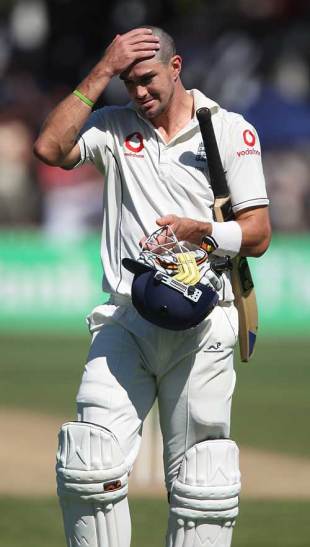|
|
|

The only one who is big and scores fast is Kevin Pietersen, and he has been out of form lately
© Getty Images
|
|
| |
England's cricketers have won a
Test match, levelled a series, and wiped most of the egg off their faces. But there's still something not quite right about them. For me, it's the composition of the top six.
The England hierarchy is always talking about the need for bowlers to perform "as a unit". You don't often hear the same point made about the batting. We pundits are partly to blame, as we are always homing in on individual stats. And individually, England's top six have good Test records, or good-looking ones, all averaging 40 (in this age of flat pitches, 40 is the new 35). But a top six is a unit too, and England's is currently adding up to less than the sum of its parts.
It's not just the shortage of hundreds, which has been widely remarked on - and which didn't go away in Wellington, where the only man to reach three figures was Tim Ambrose, a No. 7 playing his second Test. It's also their collective pace, punch and presence. They're a bit small and a bit slow. The only one who is big and scores fast is Kevin Pietersen, and he has been out of form lately.
England weren't just better during their golden run of 2004-05 - they were bigger. They had Marcus Trescothick and Andrew Flintoff in the top six: two big figures, uncomplicated (or so we thought), excellent team men, and intimidating to bowl at when in form, because they gave the ball a good biff.
It's no fault of anyone's that Trescothick and Flintoff have slipped out of the picture, but the men who have taken their places have been of a different stamp. Alistair Cook is much easier to tie down than Trescothick: his Test strike-rate is 45, not 54. Trescothick hit 42 sixes in his 76 Tests, whereas the only six Cook has ever scored in Test cricket came the other day, off the edge, and caused an eruption of mirth among his team-mates. Cook is an old head on young shoulders, and not always in a good way.
When Cook opens, England tend to get off to a solid start - but also a stolid one. The Test in Wellington was the first in which he has ever opened and finished on the winning side, apart from three home games against West Indies, who are terrible travellers. Cook and Andrew Strauss didn't work as an opening pair (too crabby, too alike), so now Michael Vaughan is opening, even though Strauss is back in the team. Vaughan is too elegant to be described as a biffer, but he has presence and the ability to score fast.
Collingwood is the most adaptable of all England's batsmen, capable of shovelling sixes one week and stonewalling the next. In Tests, he tends to the cautious: his strike-rate is 44. The problem isn't his record, so much as where and how he fits in. England keep switching him and Ian Bell around, just as the football team have with Steven Gerrard and Frank Lampard. The suspicion persists that there just isn't room for both of them in the same team.
The same may well apply to Cook and Strauss. Of this top six, only two are imposing enough ever to frighten the bowler: Vaughan and Pietersen. If they were both in blinding form, it would be fine for the others to play the tortoise around them. As it is, England are just too tentative. They were awful
in Hamilton, batting like some of the New Zealand sides of a generation ago, as if their only ambition in the game was to make it through to the fifth day. And they were still not right in Wellington. In the first innings they slumped to 136 for 5 and had to be bailed out by Ambrose; in the second, despite being right on top in the match, they were mousey, when a fit Trescothick would have gone out there and belted a quick 70.
| |
|
|
|
| |
| Not for nothing did Nasser Hussain, as he retired, call them the PlayStation generation. Their batting line-up is out of tune with their mindset, and of the two, it's a lot easier to change the line-up |
| |
At first glance it's not easy to see how England can fix the problem. The men who have done most to demand a call-up, Owais Shah and Mark Ramprakash, are not biffers either. But both are adaptable, both have done better than you would have expected in Twenty20 cricket, and both are intense characters who might gain from being given a licence to get on with it.
It is still just about possible to win Test matches by attrition, but Vaughan's England are just not built for it: they are too buccaneering, or impatient. Not for nothing did Nasser Hussain, as he retired, call them the PlayStation generation. Their batting line-up is out of tune with their mindset, and of the two, it's a lot easier to change the line-up.
Vaughan himself is a natural risk-taker. In this match, he gambled by dropping Matthew Hoggard as well as Steve Harmison, and by taking the new ball on Sunday evening when the light was bad. Attrition is not his way. The selectors need to give him a team that fits his style.
Tim de Lisle is a former editor of Wisden and now edits www.timdelisle.com
